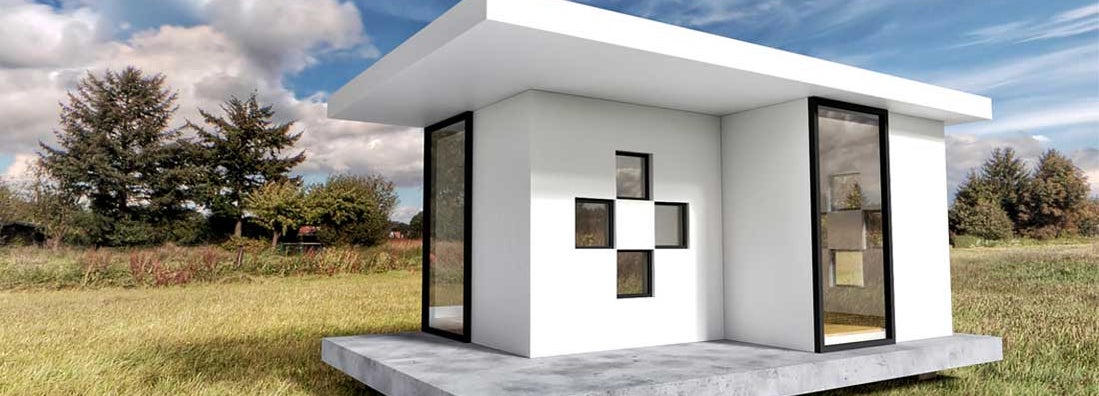Tiny House Insurance
Because even the tiniest homes can face the biggest insurance risks.

Paul Martin is the Director of Education and Development for Myron Steves, one of the largest, most respected insurance wholesalers in the southern U.S.

Though they're smaller in size than traditional homes, tiny houses can still face huge threats. Tiny homes can also be more difficult to insure than traditional homes, leaving their owners vulnerable in case of theft, fire, and other disasters. So tiny houseowners must find the right kind of coverage from the start.
Luckily, insurance companies are already adapting to the trend with new coverage options for those who own a tiny home. You also don’t have to navigate this new market alone because independent insurance agents are industry experts who can help you find the kind of homeowners insurance you need at the best possible rate. But for starters, here's a breakdown of how to insure your tiny house.
How the Average US Home Size Has Changed Over Time
According to data from the US Census, in the past 50 years, the average US home size has grown by more than 600 square feet. Back in 1973, the average US single-family home was reportedly 1,660 square feet. By 2021, this average jumped to 2,273 square feet. But believe it or not, this size has actually decreased in the past few years, considering that in 2015, the average size of a US single-family home was reportedly 2,687 square feet.
So Why Get a Tiny House?
Tiny homes allow for more economical living, environmental friendliness, and greater opportunities for personalized design. They’re easier to take care of and may better fit the lifestyles of small families and empty-nesters. Utility bills are much cheaper, and homeowners have less square footage to fill with furniture or décor.
What Counts As a Tiny Home?
Any home under 1,000 square feet could run into insurance problems as a tiny home. But it’s only once you reach truly tiny proportions (i.e., 400 to 500 square feet or less) that it becomes essential to find coverage specific to tiny homes. An independent insurance agent can help you find the appropriate coverage for a home of any size.
What Is Tiny House Insurance and How Does It Differ from Traditional Homeowners Insurance?
Tiny home insurance isn’t as black and white as other homeowners insurance policies because it can depend on the kind of tiny house you own. If you’ve built a tiny house in your backyard, the coverage for it will just be added to your existing homeowners policy as a second structure. The trick is when the tiny home is built elsewhere or on wheels.
If you’re building a stationary tiny house on a separate lot you purchased, you will likely have to look to the surplus insurance market to find a policy. Traditional homeowners insurance companies are unlikely to be interested in insuring a stationary tiny home, because the annual premiums they’d be able to charge would be too low to be profitable. However, an independent insurance agent can still help point you in the right direction to find coverage.
If your tiny house is mobile or "on wheels,” you’ll need an RV or mobile home insurance policy that can be tweaked to cover your unique property. Many tiny house owners opt to go with an RV insurance policy because it covers the home while it’s in motion and stationary. Once fashioned into a tiny house insurance policy, it’ll cover liability concerns, collision, physical damage, and more.
What Does Tiny House Insurance Cover?
Assuming your tiny house is mobile and unable to be added to your current homeowners policy as a second structure, it will need coverage to protect it and other vehicles while on the road, as well as coverage for the structure and its contents while stationary. Tiny house insurance packages are essentially a reworking of RV insurance packages, and they sometimes also draw elements of mobile home insurance for a true hybrid policy.
Because of the unique nature of mobile tiny homes, it’s difficult to pinpoint the exact coverages that may come together in your tiny house insurance package. However, you can get a better idea of the coverage options available that may constitute your policy.
Your tiny house insurance package may be made up of these coverages:
- Collision: Covers repair or replacement of your tiny house if it gets damaged or destroyed in an accident.
- Comprehensive: Covers damage to your tiny house from perils such as theft and natural disasters.
- Liability coverage: Covers legal expenses such as attorney and court fees if you or a family member get sued for bodily injury or property damage to a third party on the road or while parked.
- Medical payments: Covers medical bills and other expenses if you’re involved in an accident and the other party gets injured, no matter whose fault it was.
- Uninsured/underinsured motorists: Covers you if the other driver involved in a collision does not have any/adequate insurance to fully cover resulting expenses.
These coverages help protect your tiny house while it’s in motion, but you still need coverage while it’s parked. That’s where components from a mobile home insurance policy may come in to complete your package. These coverage options often include:
- Property coverage: This protects the structure of your tiny home from common perils like fire, certain natural disasters, theft/vandalism, and more.
- Contents coverage: This offers protection for your personal belongings, like furniture, clothing, knickknacks, etc., from common perils like fire and theft.
An independent insurance agent will work with you to assemble a tiny house insurance package that meets all your needs. Be sure to tell them how you’ll use your tiny house, where it’s located, etc., to walk away with all the protection necessary to keep your home safe.
What Doesn't Tiny House Insurance Cover?
When it comes to insuring a home of any kind, unfortunately, there’s no insurance package or policy that’ll cover absolutely everything. Becoming familiar with what your tiny house insurance policy doesn’t cover can save you the hassle of filing claims that are bound to get denied, and in the event of certain non-covered natural disasters, help you find the right kind of policy to protect your home.
Tiny house insurance does not cover the following perils:
- Certain natural disasters (i.e., floods, earthquakes, and mudslides)
- Maintenance-related losses
- Wear and tear damage (i.e., failure of the owner to maintain upkeep of the home)
- Insect damage or infestations
- Damage from war or nuclear fallout
- Business-related liability
If you run a business out of your tiny house (even partially), tiny house insurance typically won’t cover any liability-related mishaps. Tiny house insurance policies also tend to limit liability coverage for certain types of vehicles, including aircraft, ATVs, and boats, and have very specific exceptions for certain powered vehicles, such as riding lawnmowers. Double-check your specific policy to be sure of coverage for special vehicles.
To protect your tiny house against flood or earthquake damage, you’ll need a flood insurance or earth movement policy. Flood insurance policies are only available through the National Flood Insurance Program, which is part of FEMA. Tiny house owners may want to seriously consider getting a policy if their home is located in an area prone to flooding.
How Does Tiny Home Insurance Work?
Tiny home insurance follows the same process as all other types of insurance. Premiums are paid monthly, quarterly, or yearly to an insurance company in exchange for coverage for circumstances outlined in the insurance contract. So if your tiny home got destroyed by a covered fire, your tiny home insurance would help pay to repair or replace your home and belongings up to your policy's limits.
What Insurance Challenges Do Tiny Homes Present?
Tiny homes can pose insurance challenges due to their size, value, design, materials, and portability (in the case of mobile tiny homes). You'll need to consider these aspects of your tiny home when shopping for coverage:
- Size: Smaller homes tend to be more vulnerable to wind damage and other natural disasters. In tiny kitchens, fire is also a significant risk. Accidents in tiny homes are more likely to damage or destroy the entire home as opposed to only a small part.
- Value: Tiny homes are partly meant to counter a consumerist culture of overconsumption. A tiny home is worth significantly less than a traditional home. The math of homeowners insurance is designed for large values, so the cost/benefit calculation on a tiny home can get confusing for both the insurer and the insured.
- Design and materials: Tiny homes are often homemade and may be built from lightweight or eco-friendly materials that present different risks than traditional construction materials. Even if these factors don’t inherently make the home less safe, they present an unknown quantity for the insurance company.
- Portability: Whether your tiny home is a modified RV or trailer or simply a home that can be towed, this adds not only risks incurred in travel (e.g., an accident while driving), but also different local risks that can significantly affect the cost of insurance. Setting up your tiny home near a Gulf Coast beach would have very different risks than camping in a remote valley in the Rocky Mountains.
All of these factors make tiny homes harder to insure than traditional homes. Luckily, that doesn’t mean they're impossible to insure. But tiny home residents need to do more legwork to find the right homeowners insurance. That's where an independent insurance agent can help considerably.
What Your Independent Insurance Agent Needs to Know about Your Tiny Home
Independent insurance agents are experts who can walk you through every step of buying insurance for your tiny home. Here are some of the most important questions they're likely to ask to help you find coverage:
- How much is it worth?
- What is the square footage?
- When was it built?
- What materials is it made of, especially exterior wall and roofing materials?
- How was it constructed? (Prefabricated, built by contractors, built yourself, etc.)
- Is it mobile? If so, where and how do you plan on traveling with it?
- Who lives in the tiny home? Will children or pets be living there?
- What types of appliances are inside?
- How do you heat or cool it?
- Does your house have plumbing with running water?
- Are there water sources nearby that firefighters could use in case of fire? (Even a nearby pool or natural water source like a pond could count for this.)
- What do you want out of tiny home insurance? What coverage (fire, theft, liability, etc.) is most important to you?
Thinking about the answers to these questions ahead of time streamlines the process for you and your agent. It's also a good idea to create an inventory of the belongings you keep in the home, especially valuables.
Who Needs Tiny Home Insurance?
Those who own a tiny home need insurance for the same reasons as traditional homeowners because most people don’t have enough cash on hand to comfortably pay for a lawsuit or replace their home and belongings in case of physical damage or theft. There are a couple of major differences between the needs of tiny homeowners and traditional homeowners, however, including:
- Less financing or no financing: Because tiny homes are cheaper to build and maintain, tiny homeowners may take out much less financing to build or purchase them, or even no financing at all. Most mortgage lenders require home buyers to carry homeowners insurance. If a tiny homeowner owns their home outright, they won’t be subject to this requirement.
- Lower value/cheaper replacement cost: A tiny home will probably cost less to replace than a traditional home. In addition, the stuff inside the home will also probably be cheaper to replace since tiny homes can’t fit as many belongings inside. If tiny homeowners have sufficient savings, they might choose to simply pay cash in an emergency rather than deal with filing insurance claims.
If you're unsure whether your tiny home needs additional coverage, talk with a local independent insurance agent. They'll be able to advise you on if coverage is necessary and how much.
The Best Way to Insure Tiny Homes
The right option for insuring your tiny home will depend on its specific design and the unique needs of you and your family. However, there are a few general tips and tricks for insuring tiny homes that every tiny homeowner should explore, like:
- Dwelling insurance (HO1 coverage): Dwelling insurance is the most basic kind of homeowners insurance. It covers the structure of a home for certain scenarios (or "perils") outlined in the contract. As long as your tiny home qualifies for dwelling insurance, it’s a solid, no-frills option.
- Mobile home insurance (HO7 coverage): Mobile and prefabricated homes have challenges that are similar to custom-built tiny homes, namely because of their size, lower value, and nontraditional building materials. Some insurance companies may allow you to customize a mobile home insurance policy to suit the needs of your tiny home.
- RV insurance: If your tiny home is portable, RV insurance is probably your best bet. It can handle both the risks of traveling from place to place and the different risks you’ll encounter in different areas of the country. It’s also built to handle the low value of tiny homes.
- Special programs: Some insurance companies have begun offering insurance designed especially for tiny homes. If you live in an area where these special programs are available, they’re a natural choice for tiny homeowners.
An independent insurance agent will have a working knowledge of all of these options and can help you decide which one is a good fit for you.
What Are the Benefits of Tiny House Insurance?
Whatever the size or mobility of your home, it’s meant to be your happy place. Without the proper protection, you run the risk of many common threats damaging or destroying your home, perhaps even to the extent that you’re unable to rebuild. Tiny house insurance packages provide coverage for many daily hazards homeowners face.
Tiny house insurance typically provides coverage for the following perils:
- Theft
- Vandalism
- Explosions
- Fire and smoke
- Water damage
- Aircraft or vehicle damage
- Riots
- Falling objects (and trees)
- Certain natural disasters (i.e., windstorms, hail, lightning, and blizzards)
Your independent insurance agent can help you review your tiny house insurance policy to answer any remaining questions about your coverage. They’ll also help you determine whether you’ve got enough coverage or if you should purchase more.
How Much Does Tiny House Insurance Cost?
Many factors influence the cost of a tiny house insurance policy, including the size and location of your home, the value of the structure, the contents inside, and any upgrades you’ve made. Owners of tiny houses in areas prone to severe weather or other risks like crime will be required to pay more for their insurance policies than those living in calmer, safer areas.
Coverage will typically be less than $1000 a year, possibly as low as $200 to $500 a year. But it's hard to offer an exact figure without knowing your unique situation and the specs of your individual home. Your tiny house insurance policy will likely be much less expensive than a regular homeowners policy. Still, you can expect to pay at least a couple to a few hundred dollars per year, or perhaps even more. An independent insurance agent can help find more exact quotes for you.
The Benefits of Working with an Independent Insurance Agent
Independent insurance agents have access to multiple insurance companies, ultimately finding the best coverage, accessibility, and competitive pricing while working for you. They'll help you walk away with the right tiny home insurance policy that offers the best blend of coverage and cost from a local carrier.
https://www.rocketmortgage.com/learn/average-square-footage-of-a-house
